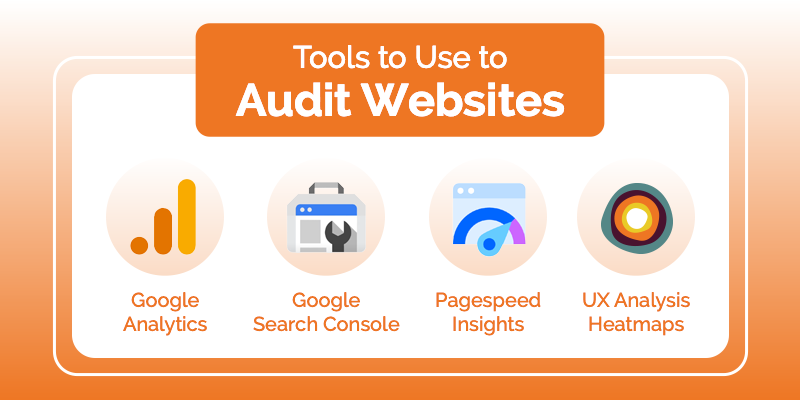The purpose of a website is to deliver the kind of information your audience is looking for. In other words, your pages and content should be designed around your users' needs and expectations, not just what you want to put out into the world. How do you know if you're delivering to your audience's expectations? Well, chances are, if you're not conducting regular website analyses, you most likely don't know.
A website performance analysis will help you understand your visitors' needs so you can improve user experience by delivering the information they're looking for when they arrive on your pages. What does this mean exactly? Read on to learn the ins and outs of a website analysis!
What is a Website Analysis?
A website analysis involves testing and reviewing your site's performance to gain greater insight into the key metrics that drive your site’s success, such as speed, traffic, and search engine optimization (SEO) elements. This process also takes user experience (UX) into account. Combined, these factors weigh into how successful (or not) your website ultimately is. And, since your website is your digital calling card that helps attract new attention to your brand, this process realistically showcases the general health of your company and its marketing efforts.
The data you collect using website monitoring tools will help you enhance your pages and guide future strategies to attract more people to your brand.
Benefits of Conducting Website Analysis
If you're searching for the right tool for website analysis, you might initially feel overwhelmed by the process. Rest assured, many platforms can assist you with your analysis so you can make the most of your efforts with as little manual effort as possible.
So, why would you embark on such an endeavor in the first place? The truth is, there are a lot of benefits that come from reviewing behavior analytics and performing SEO site analysis. The following are a few of our favorites:
1. Improve Conversion Rates
You want to make money, right? Well, here's the thing—you're not going to do that unless you can convert visitors into paying customers. And, you're not going to increase your conversion rates unless your visitors see value in the content you offer and experience a seamless journey as they navigate your site.
If you're in search of tips for analyzing websites, put the idea of improving conversion rates at the top of your list. In doing so, you'll discover ways to:
- Create/optimize call-to-action (CTA) buttons: Make sure CTAs are clear and strategically placed to guide users toward your desired end goal.
- Increase page load speeds: Slow-loading pages can drive visitors away, so speed is crucial to keep users on site and improve conversion chances.
- Simplify navigation: Clear, intuitive navigation links help users find what they’re looking for quickly, improving their journey and the likelihood of completing a desired action.
- Enhance overall user experience: A well-designed website that provides smooth and engaging user experience will encourage users to stay longer, discover more products, and complete more purchases.
2. Fix Conversion Blockers
A conversion blocker can negatively impact your brand in search results and cause frustration when human users are trying to interact with your website. This, in turn, can harm your site's performance and return on investment (ROI).
Let's say your site is filled with distractions or contains an excessive amount of information. These are conversion blockers that can cause people to leave your site as soon as — or shortly after — they arrive. In other words, you're blocking them from converting from “visitor” to “paying customer.” Additionally, broken links or inoperative forms create poor site usability, frustrating users and prompting them to abandon your site for a competitor.
Site analysis in SEO helps resolve issues that could turn the search engines — and your human customers — off before they even give your brand a chance. By identifying and fixing blockers, you not only improve your technical SEO, but also ensure a better experience for users, which encourages higher retention and conversion rates.
3. Discover Opportunities to Improve Your Site's Ranking in Search Results
Are you ranking #1 in the search engine results pages (SERPS)? If not, do you know why?
Most searchers will never click past the first page of results, making it critical to identify and implement improvements. Conducting a proper website analysis will uncover the issues that keep you on page two or lower of Google's results.
Translation: It will put your pages in front of eyes that click on your links rather than hiding your site a million pages away from anything any searcher will ever see.
During this analysis, you can identify keywords you should be using (or not), explore topics that can be great for content curation, build backlinks, and optimize your internal links, so the search engines understand the value of the content you're offering. The more valuable your content, the more likely you rank higher when Google delivers its coveted results to its searchers.
4. Uncover Competitor Strategies to Apply to Your Site
You can't be better than the next guy if you don't know what they're doing over there! A solid website analysis isn’t as effective if it doesn’t take competitors into account as well. When you embark on a site analysis project, you'll reveal strategies your competitors are taking on, from their backlinks to their content strategy, giving you the edge to do those things better.
Types of Website Audits
In the world of website analysis, there are a few different types of audits you can choose to explore, including:
- SEO Analysis: In an SEO audit, you'll determine how your site and web presence hold up to today's digital marketing best practices. This is the first step in implementing a plan that produces measurable results in the long term. By identifying technical issues, optimizing on-page elements, and aligning content with user intent, the purpose is to identify as many fundamental issues that affect your organic search performance as possible.
- Speed: Page load speed refers to the time your webpages take to render fully. The longer it takes them to show your content fully, the more people you lose. The faster your pages load, the more likely you convert visitors into customers. Optimizing images, reducing server responses times, and leveraging browser caching can improve your site’s load times.
- Competition: Collect and review data about your competitors so you can figure out how to do what they're doing better. This includes identifying their high-performing keywords, backlink sources, and content strategies.
- Traffic: When you analyze your traffic, you can collect and interpret key data points that tell you how people found your site and where they go after they leave. This analysis can also uncover which marketing channels drive the most valuable visitors, allowing you to prioritize efforts that produce the best ROI.
Tools to Use to Audit Websites
Now that you know a little more about why website analyses are important, you're probably wondering how to conduct a website analysis on your pages. Here are a few tools to keep in your toolbox:
- Google Analytics: Google Analytics captures data about your website and the users who find their way to your pages. This tool provides you with performance data that lets you see which pages perform optimally on your site and which could use a little coaching.
- Google Search Console: This will give you messages when issues are identified that need to be fixed. You can analyze your site's backlink profile, investigate technical problems that could lead to lower rankings, and monitor security issues to ensure your site is safe.
- PageSpeed Insights: This tool will ensure your webpages are loading as fast as possible on all devices. The faster your page loads, the more likely you will keep visitors engaged with your content, products, and services.
- Website UX Analysis Software (Heatmaps): Heatmaps show you which parts of your pages users engage with the most and which tend to get scrolled past and ignored. With this knowledge, you can tweak your pages to ensure you're making the most of your digital real estate.
Contact ZGM to Audit Your Website & Provide Recommendations
Don't let the woes of your website hang out by the wayside. The longer you put off your website analysis, the more customers you lose. Lean on our digital marketing team to help you uncover the following:
- How you can analyze competitors' websites
- What a user-driven website analysis actually is
- How small businesses can conduct website analyses
We're here for you: Let's talk! Get your FREE website analysis report.
About the Author
















